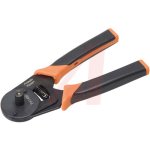kolyur
Lifetime Supporting Member + Moderator
I have to make up some cables with 9-pin D-sub connectors on one end. I've done this in the past with solder cup connectors, but I don't want to go through that aggravation again. I'd like to get the crimp-style contacts, buy a decent crimping tool, and do it right. I quickly discovered that there are two options:
(1) The open-barrel/stamped type contact, where the little tabs of the contact are simultaneously folded over and crimped onto the wire. Plus there is a second set of tabs that grip the wire insulation.
(2) The closed-barrel/machined type contact, which requires a 4-way crimping tool.
My question is for those of you who have used either or both of these options. Which one is best? I have priced both types of contacts and tools, and it's pretty much a wash so I want to base my decision on which system produces the most reliable crimp. I'd appreciate any recommendations.
(1) The open-barrel/stamped type contact, where the little tabs of the contact are simultaneously folded over and crimped onto the wire. Plus there is a second set of tabs that grip the wire insulation.
(2) The closed-barrel/machined type contact, which requires a 4-way crimping tool.
My question is for those of you who have used either or both of these options. Which one is best? I have priced both types of contacts and tools, and it's pretty much a wash so I want to base my decision on which system produces the most reliable crimp. I'd appreciate any recommendations.




